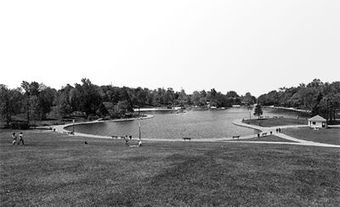Gauthier Guité Roy
The firm of Gauthier Guité Roy was formed in 1966 when the architect Jean-Marie Roy (b at St-Léon de Standon 1925-) joined Paul Gauthier (b at Gaspé 1935- ), and Gilles Guité (b at Bonaventure 1935 ), two young graduates from the Université de Montréal and partners since 1962. Attention had already been drawn to Gauthier and Guité by their design of the faculty of agriculture (Pavillon Paul-Comtois - 1964) at Université Laval in Québec City. This building differed from previous pavilions on campus by its layout that broke with the Beaux-Arts scheme of Edouard Fiset's master plan, and its asserted modernism: pre-fabricated concrete modules; absence of a façade; rough textured surfaces on the stair towers; and a wing mounted on stilts. Today the Pavillon Paul-Comptois is recognized as a major example of 1960s Quebec architecture.
Gauthier and Guité's association with Jean-Marie Roy followed their collaboration on the major Campus intercommunautaire Saint-Augustin project, near Québec City, whose overall plan had been drawn up by Roy (1962-1966). Among the campus buildings, the firm of Gauthier Guité designed the Résidence des Pères assomptionnistes, while Roy himself undertook the plans for several other pavillions (l'École normale Notre-Dame-de-Foy, le Pavillon André-Coindre, la Résidence des Pères de la Consolata, and le Séminaire Saint-Augustin).
The context of the Quiet Revolution enabled the firm of Gauthier Guité Roy to establish itself among the leaders of modern architecture in Québec. A spirit of experimentation and innovation fouled by the excitement of those years marks their work, and their interpretation of modernism united formal refinement with an excellent mastery of structure and materials. These characteristics are found in different guises such as the Musée d'Art contemporain (Gauthier Guité - 1967); Cité du Havre in Montréal; and the CEQ (Centrale des Enseignants du Québec) building in Québec City (Gauthier Guité Roy - 1967). The Édifice Marie-Guyart or Complexe G (Gauthier Guité Roy with Fiset et Deschamps, 1968) - a big office building with a tower on Québec's Parliament Hill - makes up one of the most complete examples of this architecture of the Quiet Revolution. The project demonstrates a fluid urban design, integrating interior and exterior space while blending with the old-style parliament buildings and the particular topography of the location.
The Université Laval's Phys ed and sports pavilion (1969-71), combines the sloping topography of the site with a series of horizontal volumes of terraces and footbridges as per the approaches of Frank Lloyd Wright.
This spirit continued through the 1970s, with projects like Les Forges du Saint-Maurice/The St Maurice Forges (Gauthier Guité Roy - 1977) and the residential building Les Jardins Mérici (Gauthier Guité Roy - Québec, 1978). For the Forges rehabilitation project the firm won an architectural competition that specifically asked for the creation of expressive volumes. They conceived a series of steel pyramidal forms that evoked ancient architecture and articulated the site's landscape.
At the same time Gauthier Guité Roy designed numerous residences in the Québec region and continued to develop wooden structures that greatly contributed to their reputation (la Résidence Gobeil in Sept-Îles, 1967). The use of wooden structures whose inspiration dates back to Scandinavian modernists like Alvar Aalto (Villa Mairea, 1937-38) here united the Americanism that characterised the whole of their work.
With the difficult economic situation of the 1980s on one hand, and the sweeping wave of postmodernist architecture on the other, the Modern movement faced some challenges. Gauthier Guité Roy were able to differentiate themselves from other firms by responding to the new concerns while still maintaining their modernist attitude, as with Phase 1 of the Faubourg Laudance Project, on rue du Campanile in Québec City (Gauthier Guité Roy with D'Anjou, Moisan et Associés, 1985). In this very successful project, the architects exploited the principles of traditional urban organization while avoiding the superficial historicism of postmodernism.
Following Jean-Marie Roy's retirement in 1988, Gauthier Guité got a new lease on life by associating with the architects Daoust et Lestage. In addition to Québec City, Gauthier Guité Daoust Lestage maintained an office in Montréal from 1988 to 1996. The firm distinguished itself by developing an original approach to the urban context - respecting history yet remaining openly contemporary as in the Canadian Forces Fleet School at Pointe-à-Carcy, Québec (1992) and the Centre d'Interprétation de Place-Royale, also in Québec (1997).
The firm also conceived the Centre de Recherche Forintek (Québec, 1994), a building whose large-sized wooden structure was featured by the magazine The Canadian Architect (June 1996). In addition, this building won prizes from the Canadian Wood council, the American Wood Council in Washington D.C., as well as the Prix d'excellence de l'Ordre des Architectes du Québec.
The firm of Gauthier Guité Roy thus maintained a major architectural office in Québec for more than thirty years. Through the different stages of its development, it earned numerous tokens of recognition, including the Médaille Massey (le chalet Paul Gauthier, 1969), the Governor General's Award (les Forges du Saint-Maurice, 1986; le Faubourg Laudance Phase 1, 1990), the Prix d'excellence de l'Ordre des Architectes du Québec (les Jardins Mérici, 1978; l'École Navale de Pointe-à-Carcy, 1995; le Centre de Recherches Forintek, 1996), and the Prix du Conseil canadien de l'Habitation (Les Jardins Mérici, 1974).
Gilles Guité retired in 2000. Paul Gauthier remained with Daoust et Lestage until 2003. Since then, under the name Paul Gauthier Architecte he continues to practise in association with different firms on a project basis.

 Share on Facebook
Share on Facebook Share on X
Share on X Share by Email
Share by Email Share on Google Classroom
Share on Google Classroom


